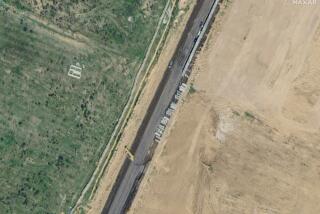In Baghdad, a wall rises to contain bloodshed
BAGHDAD — A U.S. military brigade is constructing a 3-mile-long concrete wall to cut off one of the capital’s most restive Sunni Arab districts from the Shiite Muslim neighborhoods that surround it, raising concern about the further Balkanization of Iraq’s most populous and violent city.
U.S. commanders in northern Baghdad said the 12-foot-high barrier would make it more difficult for suicide bombers to strike and for death squads and militia fighters from sectarian factions to attack one another and then slip back to their home turf. Construction began April 10 and is expected to be completed by the end of the month.
Although Baghdad is replete with blast walls, checkpoints and other temporary barriers, including a massive wall around the Green Zone, the barrier being constructed in Adhamiya would be the first to be based in essence on sectarian considerations.
A largely Sunni district, Adhamiya is one of Baghdad’s trouble spots, avoided not only by Shiites, but Sunni outsiders as well. The area is almost completely surrounded by Shiite-dominated districts such as Shamasiya and Gurayaat.
The ambitious project is a sign of how far the U.S. military will go to end the bloodshed in Iraq. But U.S. officials denied that it was a central tactic of the U.S.-Iraqi security crackdown launched Feb. 13.
“We defer to commanders on the ground, but dividing up the entire city with barriers is not part of the plan,” U.S. military spokesman Army Lt. Col. Christopher Garver said Thursday.
News of the construction was first reported Thursday by the Stars and Stripes newspaper
Shiite and Sunni Arabs living in the shadow of the barrier were united in their contempt for the imposing new structure.
“Are they trying to divide us into different sectarian cantons?” said a Sunni drugstore owner in Adhamiya, who would identify himself only as Abu Ahmed, 44. “This will deepen the sectarian strife and only serve to abort efforts aimed at reconciliation.”
Some of Ahmed’s customers come from Shiite or mixed neighborhoods that are now cut off by large barriers along a main highway. Customers and others seeking to cross into the Sunni district must park their cars outside Adhamiya, walk through a narrow passage in the wall and take taxis on the other side.
Several residents interviewed likened the project to the massive barriers built by Israel around some Palestinian zones.
“Are we in the West Bank?” asked Abu Qusay, 48, a pharmacist who said that he wouldn’t be able to get to his favorite kebab restaurant in Adhamiya.
Residents complained that Baghdad already has been dissected by hundreds of barriers that cause daily traffic snarls.
Some predicted the new wall would become a target of militants on both sides. Last week, construction crews came under small-arms fire, military officials said.
“I feel this is the beginning of a pattern of what the whole of Iraq is going to look like, divided by sectarian and racial criteria,” Abu Marwan, 50, a Shiite pharmacist, said.
Marwan lives in a mostly Shiite area adjoining the wall, but works in Adhamiya. Since the wall was begun, he has had to walk to work rather than drive.
Najim Sadoon, 51, was worried that he would lose customers at his housewares store. “This closure of the street will have severe economic hardships,” he said. “Transportation fees will increase. Customers who used to come here in their cars will now prefer to go to other places.”
Majid Fadhil, 43, a Shiite police commissioner in a neighborhood north of the wall, said flatly, “This fence is not going to work.”
So far, the barriers have cut off streets and sidewalks, avoiding homes and backyards, residents said.
Pentagon officials first broached the idea of creating “gated communities” in Baghdad this year.
But more recently, military officials have emphasized political negotiation as well as increased troop presence as a way to stem sectarian conflict.
On a tour of the Middle East this week, Defense Secretary Robert M. Gates repeatedly struck chords of unity and reconciliation. He is expected to meet with sectarian leaders and government officials in Baghdad today.
The construction in Adhamiya is not the first time U.S. military planners have attempted to isolate hostile regions. In 2005, U.S. troops tried to surround the Sunni-dominated city of Samarra with earthen berms to prevent insurgents from entering and leaving the city. A similar strategy was deployed in Tall Afar and Fallouja. Experiments with less extensive walls and trenches also have been attempted in Baghdad and Kirkuk.
The latest project is the work of the 407th Brigade Support Battalion, part of the 82nd Airborne Division, based in north Baghdad’s Camp Taji. Since April 10, soldiers have ventured out almost nightly after curfew, overseeing installation of the 14,000-pound wall segments, using giant construction cranes and employing Iraqi crews, said Army Sgt. Michael Pryor, a public affairs specialist for the unit.
Soldiers have dubbed the project the “The Great Wall of Adhamiya.” Commanders in the 82nd Airborne could not be reached for comment Thursday. In a press release Tuesday, military officials said the project was intended to protect citizens on both sides.
The wall is “on a fault line of Sunni and Shia, and the idea is to curb some of the self-sustaining violence by controlling who has access to the neighborhoods,” Army Capt. Marc Sanborn, brigade engineer for the project, said in the release. He said the concept was closer to an exclusive gated community in the United States than to China’s Great Wall.
In an e-mail, Pryor said it was too soon to judge how residents would respond.
“Bear in mind that the wall is an ongoing project,” Pryor wrote. “We’re not completely sure how the population feels either way.”
A special correspondent in Baghdad contributed to this report.
More to Read
Sign up for Essential California
The most important California stories and recommendations in your inbox every morning.
You may occasionally receive promotional content from the Los Angeles Times.










